Abstract
The landscaping in cities provides, continuously, people with high visual, emotional and physical performance with access to different plant morphological architectures, leaves, trunks, flowers, fruits and seed colors. The shadows caused by the leaves of the trees allows a comfortable atmosphere with the temperature reduction, air humidity increase and environment aromatization of gardens, parks and streets by the volatile organic compound emission by leaves, stems and flowers. The combinations of these environmental factors improve the plant, animal and Homo sapiens development. The plant architectural distribution in high-slope areas minimizes problems such as flood sand landslides in urban centers, being an economically viable and sustainable alternative for heritage preservation, the physical structure soil and optimization of water flow. The landscaping of cities is the perfect setting for meeting people, recording videos and photos for personal archives, social media, developing personal and business marketing projects and network.
Keywords
- garden
- healthy life
- urban projects
- architecture
- nature preservation
1. Introduction
The sustainable landscaping is the balance between the beauty of urban space and the preservation of nature. Projects with sustainability use techniques to build the beauty of the scenery efficiently using natural and artificial resources with practices that minimize the use of substances harmful to health and the environment [1].
The sustainable gardens provide a comfortable environment with a pleasant climate, thermal stability, soil covered with plants and high air quality. Sustainable landscaping makes it possible to increase the longevity of people’s lives as it allows interaction with a healthy natural environment, ideal for leisure, sports, relaxation and stress relief [2]. One of the goals of sustainability in landscaping is to contribute to people’s awareness of the importance of preserving nature [3].
Urbanization is the development of cities, the construction of houses, buildings, condominiums, hospitals, schools, universities, parks, streets, avenues and viaducts, basic sanitation and electricity networks. This development occurs with population growth in a given location, improving the structure of small towns and large urban centers. In planning the landscaping project, solutions must be sought for social, economic and nature destruction problems in large urban centers and also in small towns where there is no awareness of the importance of preserving nature [3, 4].
The sustainable landscaping has, socially, the green area as a place of education for people by creating spaces integrating buildings and plants. Culturally, sustainable landscaping projects aim to preserve heritage by expressing the local natural memory, harmoniously integrating the green area with the original characteristics of existing buildings, native vegetation, mineral resources and works of art [5].
Economically, sustainable landscaping selects materials with a high quality standard certified by international quality standards for the construction of concrete structures, lighting, water drainage networks and decoration. The selected plants can be native and plants adapted to the climate of the place where the sustainable landscaping project will be built and cultivated [3].
Developing sustainable landscaping projects, planting and building gardens, educating and encouraging the use of plants in homes, streets and parks is a noble mission and helps to keep nature alive, green and blooming in cities. Small gardens can be built in public spaces, as many cities have urban voids that could be used as spaces for living together and contemplating the fauna and flora of the region [6, 7].
In large urban centers, the huge surface of concrete and asphalt in the hot season release heat and increase the temperature. To reduce the effects of this event, ecological roofs known as the green roof are built, which is a covering of plants in buildings with waterproofing and cultivation techniques, being built by a team of qualified professionals. Green roofs have gained more and more space in urbanization projects in large cities, where the square meter of land generally has a high financial value [2].
On the green roofs, several species of plants are cultivated with a high capacity for shading and cooling the atmosphere, reducing the temperature and increasing the relative humidity of the air, promoting thermal comfort and beauty to be contemplated, being seen from the air, by pedestrians, cyclists and passengers by car and bus [8].
In buildings with a green roof, the internal temperature of the apartments and collective spaces is pleasant and there is energy savings with less use of air conditioning, increasing sustainability in the landscaping. Plants provide oxygen, make the environment more humid and attenuate noise, reducing the need for investment in acoustic insulation [4].
Vertical gardens optimize space when there is a reduction in the horizontal surface available for garden construction. In vertical garden projects, vases, green roofs must be positioned and cultivated in spaces with incidence of light, radiation, ventilation and water drainage system for irrigation of plants. Shady spaces can be ornamented with plants that are more efficient in using light [2].
For the garden to remain beautiful and healthy, periodic maintenance is necessary using techniques of fertilization, irrigation, pest control, pruning and removal of invasive plants. Sustainable practices reduce the use of irrigation, pesticides, fertilizers and conserve the soil by preventing erosion and sedimentation. In landscaping projects with artificial lakes, water filters must be constantly maintained to ensure water quality [3].
The heating of the real estate market in recent years and the growing desire of people to live surrounded by quality properties designed to meet expectations and environmental requirements. Landscapers, real estate developers, construction companies and public bodies have preferred the use of large native trees due to the rapid appreciation that these compositions bring to the urban environment and because they are efficient in restoring the balance of the local ecosystem [9]. The offer of sustainable gardening and landscaping services has increased and companies have specialized in sustainability to offer customers innovative and sophisticated landscaping projects, always aiming to promote people’s well-being [7].
2. Tree shadows
Trees provide shade to the environment, beautify, refresh, offer shelter to animals (Figure 1). In urban landscaping to plant trees there is the process of planning space, tree species, maintenance, tree height and root depth [6].

Figure 1.
Trees in sustainable landscaping and walkways.
The trees have several important functions such as producing, such as fruits, flowers, shade and good thermal sensation under their large branches and leaves (Figure 2). Fast growing shade trees are preferred in urban landscaping. There are several species of trees that grow quickly and provide excellent shade, such as the

Figure 2.
Architecture of squares with trees for people to live together.
2.1 Comfortable atmosphere
In landscaping, flowers enchant us mainly for their vibrant colors and natural scent (Figure 3). The flowers of the plants exude a pleasant scent. The scent of the flowers serves to attract the sense of smell and bring the attractant closer to the flowers. The evolutionary target of these attractive resources to people and the perfume and cosmetics industry is not the human being. Bees, butterflies and flies are the target that flowers want to reach with the scent for noble reasons. These animals are the main pollinators of plants. When they land from flower to flower, they spread the pollen and ensure the fertilization of flowers in other places, increasing the genetic variability of the plants. There are also other forms of pollination, such as wind and water, but animals are the most important agents. They also benefit from this contact with flowers, since they can feed on their nectar [3, 10].

Figure 3.
Garden with vibrantly colored flowers.
Bees are attracted to blue and yellow flowers. This is due to the fact that these animals see ultraviolet light. In addition, they prefer flowers that smell like fermenting food [1].
The showy flowers usually attract birds, as they have great eyesight. The odor of these plants, however, is not strong, since birds do not have a keen sense of smell. Another characteristic of the flowers visited by birds is the large amount of nectar found in them, thus ensuring adequate nutrition for the animal [3].
Flowers pollinated by butterflies are also showy, usually red, yellow and blue (Figure 4). In addition, these flowers make their nectar accessible (Figures 5 and 6) only to some species that have a long mouthparts [3]. Flowers with the smell of ripe fruit and little coloration are normally pollinated by bats. As these animals have nocturnal habits, the color of the flowers would not be a form of attraction. Flowers pollinated by beetles are also less showy and usually white [3].

Figure 4.
Butterfly pollinating the flower.

Figure 5.
Bees pollinating the flowers.

Figure 6.
Bird visiting the flowers.
Plants are sessile organisms and to compensate for their immobility, they have developed several mechanisms of interaction with the environment, including the release of volatile organic compounds into the soil and atmosphere from roots, fruits, flowers and leaves. The carbon fixed by plants is emitted back into the atmosphere in the form of volatile organic compounds. These emissions by vegetation play a fundamental role in the chemistry of the atmosphere, mainly in the aroma of the atmosphere [11].
The effect of absorbing the aroma in the human organism is fast, causing the body to respond both physically and in the deepest energies and emotions. The sense of smell is the most refined of the senses, guaranteeing the profound effect of aromatherapy, because when you feel a specific smell, it immediately awakens your emotions. Therefore, aromas are able to balance health, increase the feeling of happiness and awareness. Flowers have a higher vibration than we do, as they have no mental capacity. When a person comes into contact with a flower or a plant, their energy vibration also rises, favoring the maintenance and restoration of health [1].
3. Enhancement of comfort for high performance life development with sustainable landscaping
The combination of environmental factors optimizes the development of plant and animal life and homo sapiens species. The connection of knowledge in architecture and design with research in biology, sociology and the interest of people, companies and government give rise to natural landscapes in urban spaces (Figures 7–13) with a meaning of spontaneous social interaction and a dream of an open heritage for the pleasant experience in the community that is essential for human health [12].

Figure 7.
Large urban center square with sustainable landscaping project.

Figure 8.
Sustainable landscaping design in parks within large cities.

Figure 9.
Sustainable landscaping project for urban condominiums.

Figure 10.
Young people practicing physical activity in a park with sustainable landscaping.

Figure 11.
Vertical garden design in modernized urban centers.

Figure 12.
Sustainable landscaping project for urban residence.

Figure 13.
Sustainable garden for homes.
The green roof favors the region’s biome as it is home to wild animals that can make the neighborhood more pleasant and beautiful (Figure 14). The green roof reduces the temperature at the top of a building by up to 5°C, in addition to minimizing the heat islands in cities. It is one of the alternatives to save money, as the captured rainwater can be used to clean environments, gardening and also in the bathroom, in toilets. When treated, filtered and purified, this water can be made potable, stored and sold. The consumption of water captured on green roofs is a benefit for everyone because there is a decrease in the consumption of drinking water [13].

Figure 14.
Green roof in sustainable landscaping projects.
The construction of green roofs reduces flooding on streets and avenues, as the detention basin on the roofs makes it possible to reduce flooding in large cities, where there are few green areas and a lot of paved area, making it difficult for water to flow in the rainy season [14].
Landscaping is rich in sensory stimuli, as nature has its constant and unpredictable movements. They are the ones that involve our senses and contribute to well-being. The backyard design in the landscaping brings the connection with nature in a mentally and physically restorative space and with the availability of fresh and natural fruits available for naturally healthy eating. A natural refuge that envelops our senses and from which it is possible to observe the surroundings, but from a protected position, far from the hustle and bustle of the city [10].
4. Landscaping architecture
Sustainable architecture means planning including organic and conscious actions in the external space of houses, buildings and buildings, resulting in sustainable landscaping (Figure 15). The daily practice of professionals and offices with a focus on sustainability in landscaping projects must have the natural resources to balance the environment in urban areas and in spaces of common use (Figures 16 and 17). Sustainable architecture projects beautiful, pleasant, spacious, harmonious scenarios (Figures 18–22) to allow a functional routine and total respect for nature and inhabitants [10].

Figure 15.
Building with innovative architectural design and vertical garden.

Figure 16.
Balcony of building with innovative architectural design and vertical garden.
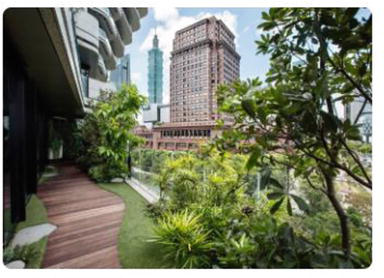
Figure 17.
Ground floor garden of building with innovative architectural design and vertical garden.
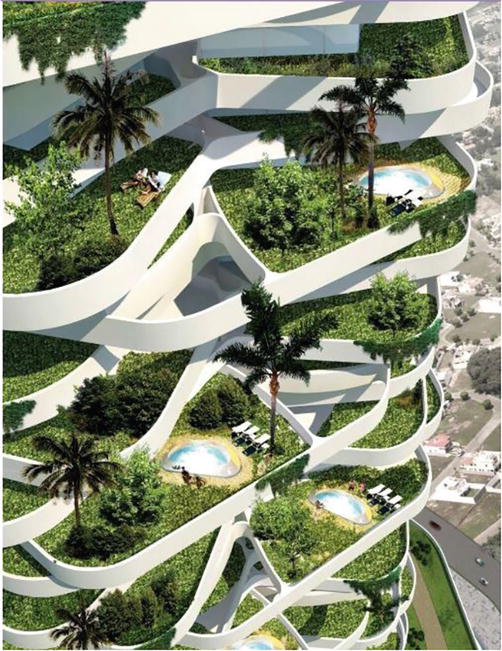
Figure 18.
Sustainable landscaping project with innovative architecture.
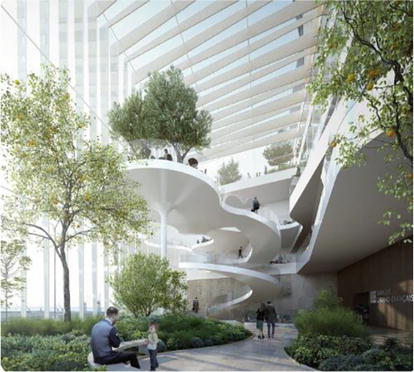
Figure 19.
Landscaping project in buildings with innovative architecture design.
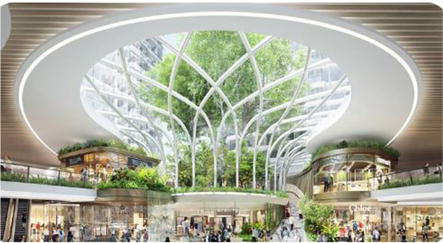
Figure 20.
Sustainable landscaping project for the interior of large.
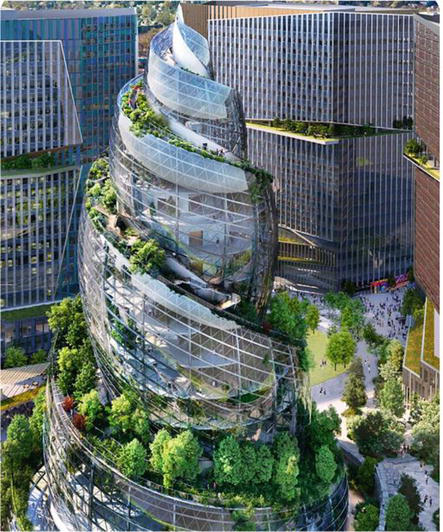
Figure 21.
Sustainable landscaping project developed for the Amazon office complex.
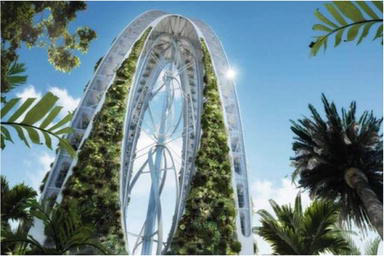
Figure 22.
Vertical forest design using modern engineering techniques.
The distribution of plants in an architectural way in areas of high declivity minimizes problems such as floods and landslides in urban centers, being one of the economically viable and sustainable alternatives for heritage preservation in cities [15].
4.1 The oriental garden in sustainable landscaping
The oriental garden is a powerful source of tranquility and serenity in the modern world. Oriental design is perfect for creating interiors and exteriors that stand out for the feeling of peace, balance and contemplation capable of stimulating and transmitting (Figure 23). In this type of garden, the choice and arrangement of resources are carried out with care and the elements have their role and function in the composition of the landscape [6].
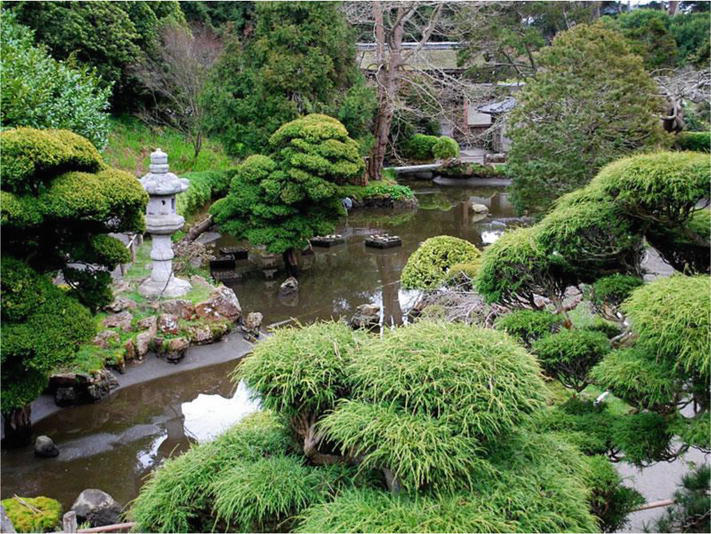
Figure 23.
Natural elements of the oriental garden in sustainable landscaping projects.
Oriental gardens are based on balance with the good use of natural elements, excellence in landscaping and in the choice of accessories. Contemplating the oriental gardens is like living and a private oasis dedicated to recharging energies. The assembly of the oriental garden can be carried out by specialized companies. The oriental garden is the reproduction of some elements of the planet and its natural resources. The stones represent the mountains and islands, the sand can be associated with the passage of time, while the paths and passages refer to the journey of life itself. The garden is inspired by the culture of the East, symbolism is the striking aspect in the design of the oriental garden. The presence of the water element is of fundamental importance in the design of oriental gardens and is associated with calming feelings and mental relaxation and appears in the form of fountains, amphorae, lakes, wells and waterfalls. The lakes characteristic of oriental gardens play an important role in meditation [6].
Bridges carry symbolism and esthetic appeal in the composition of oriental gardens and can be used for better use of space and also for contemplation. Stone laying is considered an art form in Asia and can be used to highlight the flower bed, plants and water features. Stones also help to direct the focal point in oriental gardens. The selection of decorative stones of varying sizes helps to reproduce the natural environment in the garden and promote relaxation and mental tranquility [6, 16].
Trees are especially important, providing shade and exploration of vertical space in the eastern garden. Japanese maple is one of the species traditionally found in oriental gardens. The choice of plants is based on the color, fragrance and texture of the species. Lilies, Nandina domestica and peonies are some of the popular choices in this type of landscape. Bamboo is the traditional plant of the oriental garden, being used in the construction of gates, flowerbeds, fountains and other accessories [3, 17].
5. Preservation of the physical structure of the soil
The sustainable landscaping reduces damage to residential, commercial and public buildings. Erosion caused by rainfall results in property degradation. Nutrient loss, soil compaction, and reduced biodiversity of soil organisms can severely limit landscaping vitality. Sedimentation caused by erosion increases turbidity levels, which degrades aquatic habitats, and the accumulation of sediments in water channels can reduce flow capacity, causing flooding that floods streets and houses. The design of landscaping architecture (Figure 24) optimizes rainwater runoff and makes it sustainable to invest in landscaping projects in areas with problems in the physical structure of the soil [1].
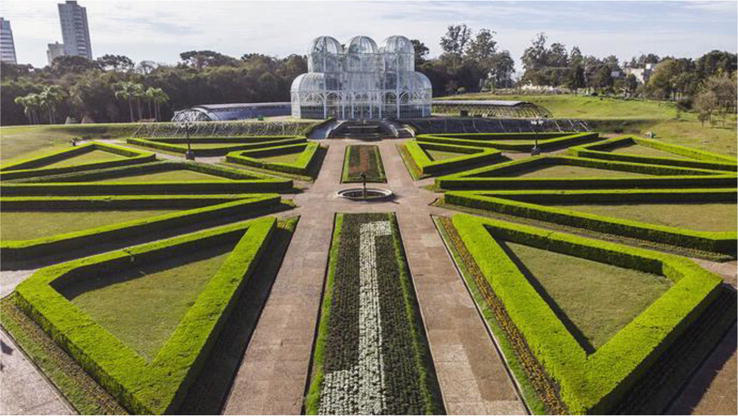
Figure 24.
Preservation of the physical structure of the soil with cover of plants distributed in the design of the square.
6. Conclusions
Sustainable landscaping makes it possible to reuse rainwater for irrigation of plants, the cultivation of native species in cities, soil conservation, energy and water savings, thermal comfort and esthetics for residential, commercial, public and corporate developments.
Cities with sustainable landscaping projects have a decrease in temperature, an increase in relative humidity, an oxygenated atmosphere, noise filtering and more water available for use. Sustainable gardens educate people to care for nature and to live in high natural performance.
Notes/thanks/other declarations
Thanks to all the authors of the articles and books that were used as reference in the writing of this chapter.
References
- 1.
Hsu CY, Ou SJ. Innovative practice of sustainable landscape architecture education—Parametric-aided design and application. Sustainability. 2022; 14 :4627. DOI: 10.3390/su14084627 - 2.
King J, Holmes R, Burkholder S, Holzman J, Suedel B. Advancing nature-based solutions by leveraging engineering with nature® strategies and landscape architectural practices in highly collaborative settings. Integrated Environmental Assessment and Management. 2022; 18 :108-114. DOI: 10.1002/ieam.4473 - 3.
Waldheim C. Landscape as Urbanism: A General Theory. Princeton: Princeton University Press; 2016. DOI: 10.1515/9781400880546 - 4.
Xi J, Wang X. Development of landscape architecture design students’ pro-environmental awareness by project-based learning. Sustainability. 2022; 14 :2164. DOI: 10.3390/su14042164 - 5.
Kuper R. Policy brief: Alternatives to In-person American Society of Landscape Architects Conferences on landscape architecture. Landscape Journal. 2022; 41 (1):77-93. DOI: 10.3368/lj.41.1.77 - 6.
Myeong-Jun L. Back to basics in landscape architecture pedagogy through collage and model-making: A qualitative study in Korean basic-level design education. Landscape Research. 2022; 2022 :959-979. DOI: 10.1080/01426397.2022.2089641 - 7.
Nickayin SS. Paradigm shift of scale in landscape architecture—Towards a planetary observation. Sustainability. 2022; 14 :2949. DOI: 10.3390/su14052949 - 8.
Ranja H, Julia D. Modern living in a forest—Landscape architecture of Finnish forest suburbs in the 1940s–1960s. Geografiska Annaler: Series B, Human Geography. 2022; 104 (3):250-268. DOI: 10.1080/04353684.2021.1989320 - 9.
Taufen A, Yangn Y. Sustainable cities and landscapes cultivating infrastructures of health. In: Taufen A, Yangn Y, editors. The Routledge Handbook of Sustainable Cities and Landscapes in The Pacific Rim. 1st ed. Routledge: Taylor Francis Group; 2022. pp. 1-13. DOI: 10.4324/9781003033530-1 - 10.
Dane C, Mariel CA. Trajectories of practice across time: Moving beyond the histories of landscape architecture. Landscape Research. 2022; 47 (1):25-34. DOI: 10.1080/01426397.2021.1989393 - 11.
Nikologianni A, Plowman T, Brown BA. Review of embodied carbon in landscape architecture. Practice and Policy. 2022; 8 (22):1-15. DOI: 10.3390/c8020022 - 12.
Dai Y. Application of regional culture in landscape architecture design under the background of data fusion. Scientific Programming. 2022; 2022 :1-12. DOI: 10.1155/2022/6240313 - 13.
Gillian L, Sudipto R. Learning and teaching academic standards in landscape architecture. Landscape Research. 2022; 47 (7):936-958. DOI: 10.1080/01426397.2022.2089640 - 14.
Gramkow MC, Merit MT, Stigsdotter UK. A qualitative study on how Danish landscape architectural firms understand and work with accessibility. Archnet-IJAR. 2022; 16 :536-553. DOI: 10.1108/ARCH-08-2021-0233 - 15.
Fornal-Pienak B, Mária B. Evaluation of current landscape architecture approaches in chosen cities in Poland and Slovakia. Acta Horticulturae et Regiotecturae. 2022; 25 (1):28-36. DOI: 10.2478/ahr-2022-0004 - 16.
Holmes R, Burkholder S, Holzman J, King J, Suedel B. Integrating engineering with nature® strategies and landscape architecture techniques into the Sabine-to-Galveston coastal storm risk management project. Integrated Environmental Assessment and Management. 2022; 18 :63-73. DOI: 10.1002/ieam.4434 - 17.
Karsten J, Richard S, Elke M, Nilgül K. Teaching landscape architecture: A discipline comes of age. Landscape Research. 2022; 47 (2):167-178. DOI: 10.1080/01426397.2020.1849588